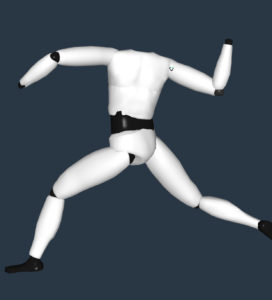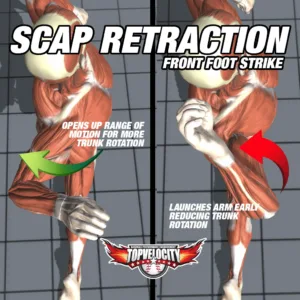 The Cuban defector who has set the new standard of pitching velocity, with his numerous 100+ mph pitches, reveals a secret of velocity that has been proven as a significant pitching velocity component of his culture. Yes, a case study has proven why Cuban pitchers rank the top in the world when it comes to pitching velocity.
The Cuban defector who has set the new standard of pitching velocity, with his numerous 100+ mph pitches, reveals a secret of velocity that has been proven as a significant pitching velocity component of his culture. Yes, a case study has proven why Cuban pitchers rank the top in the world when it comes to pitching velocity.
Before diving into this study, it is important to understand that Chapman's mechanics from toes to fingertips is one of the best in the game. You can learn why and compare him to some of the other better mechanics in the game by viewing his 3X Pitching Profile. His mechanics are definitely credit to his blazing speeds. The pitching velocity component listed in the study was not the only reason for his 100+ mph pitching velocity but is what separates him from all the other top pitchers in the world who also have very good pitching mechanics.
Cuban Study Holds Secret to Pitching Velocity
The study was performed by the Michael W. Krzyzewski Human Performance Laboratory, Duke University Medical Center, Durham, NC. It was called, Kinematic comparisons of 1996 Olympic baseball pitchers. The countries who's pitchers were used in the case study where Australia, Japan, the Netherlands, Cuba, Italy, Korea, Nicaragua and the USA. Here is the results of the study:
Twenty-one kinematic parameters were measured at lead foot contact, during the arm cocking and arm acceleration phases, and at the instant of ball release. These parameters included stride length, foot angle and foot placement; shoulder abduction, shoulder horizontal adduction and shoulder external rotation; knee and elbow flexion; upper torso, shoulder internal rotation and elbow extension angular velocities; forward and lateral trunk tilt; and ball speed...
Shoulder horizontal adduction and shoulder external rotation at lead foot contact and ball speed at the instant of ball release were significantly different among countries. The greater shoulder horizontal abduction observed in Cuban pitchers at lead foot contact is thought to be an important factor in the generation of force throughout the arm cocking and arm acceleration phases, and may in part explain why Cuban pitchers generated the greatest ball release speed.
Read the entire study here:http://www.ncbi.nlm.nih.gov/pubmed/11522142
Implementing More Horizontal Abduction During Cocking
 We need to be really careful here because when a pitcher starts changing arm patterns without changing the other body parts then injury can occur. Before defining the most effective way to implement more shoulder horizontal abduction at front foot strike into the pitching delivery, to support pitching velocity without causing injury, let's first define how Chapman gets into this position.
We need to be really careful here because when a pitcher starts changing arm patterns without changing the other body parts then injury can occur. Before defining the most effective way to implement more shoulder horizontal abduction at front foot strike into the pitching delivery, to support pitching velocity without causing injury, let's first define how Chapman gets into this position.
Chapman begins his pitching delivery by breaking his hands but notice how he does not immediately cock his throwing arm in the video clip above. He starts his legs and hips building power towards the target first. Once his drive leg Force Vector is almost in an optimal linear position he begins to cock the throwing arm up. During this throwing arm cocking he is pinching his throwing shoulder blade to pull the elbow behind the back as the throwing hand moves up into the cocked position. At this same moment his is also moving into triple extension (3X). The pinching of the throwing elbow behind the back is defined as horizontal abduction of the throwing shoulder. This horizontal abduction coupled with 3X before front foot strike (See picture), creates optimal hip to shoulder separation at front foot strike. Optimal hip to shoulder separation has many studies proving its correlation to high pitching velocities.
Speculation: Why Cuban Pitcher's Throw Harder
The only issue with this study is that it does not prove why Cuban pitchers have more shoulder horizontal abduction or why the other countries did not. This leaves us to speculate why this is the case therefore based on the make-up of one of Cuba's greatest pitching specimens Aroldis Chapman, another famous Cuban baseball player Yoenis Céspedes and the type of athlete on the Cuban National Team, what they all share in common is their amazing athletic abilities. Cuba, as one of the smallest countries in the world, has many of the top ranking athletes in the world.
This superior athletic ability is represented in Cuba's latest defector to Major League Baseball, Yoenis Céspedes. His vertical jump has been recorded at over 45 inches. I have looked hard for record of Aroldis Chapman's vertical jump record but all I have is visual proof that Chapman's vertical jump looks like that of Michael Jordan. The ESPN Sports Science Video on Chapman showed proof that he has more stride power than the average MLB pitcher as recorded in his stride distance and stride speed to hip to shoulder separation.
This is far from enough evidence but based on the information listed above, these Cuban athletes pitch with a lot more linear leg power which creates early hip rotation and timed with optimal horizontal abduction converts into optimal hip to shoulder separation, which is a credit to their superior ball speeds as listed in the Olympic case study. This is why it is important to understand first the make-up of the athlete before his mechanical components. His mechanical components are the result of his athletic ability. This is why 3X Pitching takes the same approach when it comes to increasing pitching velocity. You must build the power athlete before you can build the power pitcher.




Terrific insights. Please explain “separation” of hip and torso as in “up to 65% separation.” (Am meeting with kinesiologist to learn heir technical lingo; abduct, etc.
Thanks, Bob Nash
Here is another article to help you learn more about this key pitching velocity component. http://www.topvelocity.net/scientific-proof-that-3x-is-key-to-separation-and-pitching-velocity/